By Professor Tiffany Banks On Tuesday, September 30th , students from my COMM 108: Foundations…
by Dr. Tracie Witte, Sociology
I would sit on the metro on the way home from the Social Problems and Issues class trip to the Smithsonian’s American History Museum, feverishly writing an inspired blog post, the chatter of my own thoughts drowning out the din of the other metro riders. There were personal and academic lessons learned by students and successes and challenges of academic plans, from both content and logistic perspectives. These thoughts would flow easily and quickly across my keyboard, becoming memorialized in a word document, tucked away in a folder on my computer, until brought into the light of the blog to bring inspiration to others.
But, to say that this all came in a moment of easy inspiration, or that I am even aware of all the lessons, successes, and challenges from our Smithsonian museum trip and assignments, would be disingenuous. In fact, the very premise of the scenario above is fictional. I, like many more of my students than I had expected, had driven into DC instead of taking advantage of the public transportation options available. Although we had spent a significant amount of time in class reviewing metro maps, going over directions to get to the museum, and answering questions from anxious students about using public transportation, only a handful took advantage of this option. My expectations and the realities of this experience did not seem to be aligned. This happy disconnect occurred often throughout the process, and for that, I am grateful.
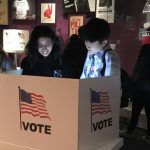 At the point in the semester when we found ourselves at the Smithsonian’s National Museum of American History, Social Problems and Issues (SOCY 105) sociology students had been exploring the social issue of immigration. Used as a transitional topic to move students from thinking about the role of power in defining/shaping social problems to beginning to think about some of the ways the media presents social problems, immigration seemed to be the perfect vehicle to connect some of the substantive Sociological content to an assignment in which students would use exhibits from the American History museum to grapple with the struggles to form an American identity. Almost tailor made for this class, the “American Democracy: A Great Leap of Faith” exhibit poses the question, “Do We Need a Shared National Identity?” while the proximate exhibit, “Many Voices, One Nation” uncovers places of negotiation asking, “who is free?”, “who is included?”, and “who is equal?”. Both of these exhibits highlight the idea that a shared national identity is created, contested, fought over. It is not fixed. The American identity is fluid, changing in response to struggles over the value systems that give the American identity its meaning. The assignment practically wrote itself.
At the point in the semester when we found ourselves at the Smithsonian’s National Museum of American History, Social Problems and Issues (SOCY 105) sociology students had been exploring the social issue of immigration. Used as a transitional topic to move students from thinking about the role of power in defining/shaping social problems to beginning to think about some of the ways the media presents social problems, immigration seemed to be the perfect vehicle to connect some of the substantive Sociological content to an assignment in which students would use exhibits from the American History museum to grapple with the struggles to form an American identity. Almost tailor made for this class, the “American Democracy: A Great Leap of Faith” exhibit poses the question, “Do We Need a Shared National Identity?” while the proximate exhibit, “Many Voices, One Nation” uncovers places of negotiation asking, “who is free?”, “who is included?”, and “who is equal?”. Both of these exhibits highlight the idea that a shared national identity is created, contested, fought over. It is not fixed. The American identity is fluid, changing in response to struggles over the value systems that give the American identity its meaning. The assignment practically wrote itself.
But, I was expecting students to take time out of their schedules and travel to Washington, DC. I was expecting students to get out of their comfort zone and learn together outside of the safety of the classroom walls. I was expecting students to have transformational experiences. Certainly one assignment would not be enough to meet those expectations. As I visited the American History museum, and the “American Democracy” and “Many Voices, One Nation” exhibits specifically, in preparation for the semester, as I gathered resources to help support this new assignment, and as I delved deeper into the processes of forming an American identity, I kept returning to the places and times of struggle. Which groups and value systems guide this collective national identity and how, when, and why does that identity change? I did not expect to re-order a significant section of this SOCY 105 class for one assignment, and I certainly did not expect the positive effect this had on the rest of the course. Moving the unit on Social Movements and Social Change to the beginning of the semester, seemingly only for logistic reasons (to fit the Smithsonian assignment in early), not only helped create a stronger foundation on which students were able to build their Smithsonian assignments, but it changed students’ approaches to our other topics for the semester in thoughtful ways.
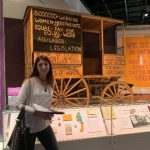

Bolstered by assigned readings for both the Immigration and Social Movements topics, class discussions, and in-class activities to help students with object-based learning, the students were ready for their two Smithsonian assignments: one in which students were asked to analyze a pre-selected object related to social change that they had worked with in a class assignment and find their own object representing some aspect of social change and a second assignment in which they were expected to find and write about an object that represented a group’s integration or marginalization within American society.
On the day of our scheduled museum visit, we met on the second floor of the American History museum between the two exhibits we would be using for the assignments in “Unity Square”, a large room with chairs and benches to rest tired feet, a wall of windows to enjoy the view of the mall, a number of interactive activities to explore issues related to Democracy, and the centerpiece of this exhibit – the Greensboro lunch counter. I expected some students to be late. Some were. Fortunately, precautions can be made for well-founded expectations. Thanks to colleagues who are more technologically savvy than I, I learned some tips and tricks to use the “Remind” app that allows for, in part, communication that does not require sharing personal contact information. This was useful when a student or two (or four) unexpectedly ended up at the wrong museum and needed some guidance to find the right Smithsonian, and to answer questions if we happened to be in different parts of the exhibits.
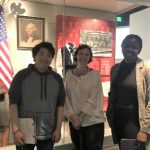 I expected to walk around with students more in the museum. I expected to impart and gain wisdom as we engaged in deep and insightful impromptu small group discussions. Although I did get the chance to engage in some really interesting conversations with students, and I did have the opportunity to experience the museum with the class, much more of my day was spent waiting for students to get there or helping students find what they needed than waxing academic with students. But my expectations were not the only ones that went differently than expected.
I expected to walk around with students more in the museum. I expected to impart and gain wisdom as we engaged in deep and insightful impromptu small group discussions. Although I did get the chance to engage in some really interesting conversations with students, and I did have the opportunity to experience the museum with the class, much more of my day was spent waiting for students to get there or helping students find what they needed than waxing academic with students. But my expectations were not the only ones that went differently than expected.
“It was wider than I thought.”
“It was a bit smaller than I expected it to be. Also the writing was a lot clearer than I thought it was going to be.”
“My favorite part of the museum was the fact that objects that you wouldn’t find in a history museum were there. Things such as video games, superheroes, and comics. These objects show that history has a way of being remembered in different ways. Also, certain things hold more value to some people than to others.”
“I think the most interesting aspect is that as a history museum, there are objects in here that are new(er than I typically think of for museums). There are social issues – represented here in objects – that are still ongoing.”
Students’ expectations were expanded from the museum visit. For some, it was the first time in a Smithsonian. For others, it was their first time they were allowed time “on their own” in a museum. Their object choices, very often, fit well within my expectations, however the freedom students were granted in choosing objects that would connect either to a social change or to the integration or marginalization of a group allowed for some creative surprises when thinking about negotiating an American identity. These choices expanded my own expectations for these students.

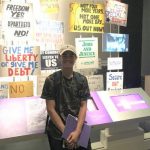
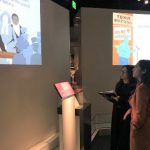
As I watched students interact with one another in the museum, take notes, and interact with objects, I hoped that many would stay beyond the given time frame and would venture beyond the confines of the two exhibits used for the assignments. And, many did. In fact, one of the last to leave were two students who, at first, seemed reluctant about the museum trip and assignment.
 “Professor, you have to come play this game with us!” Walking through Unity Square, the central meeting point for our class, I noticed that these two students had barely left this room. I figured I would watch before I joined the game. The nerdy Sociologist in me leapt (inwardly) with joy when I watched the game. Without any prompting from me, and with no grades attached, I watched (and very soon I, and others from the class, participated in) a game that matches words such as diversity, independence, equality, freedom, happiness, etc. with images. Each player must choose an image that fits the word and then discuss why that particular choice was made. In fact, these students had participated in every activity in the room writing about the American Dream, immigration experiences, looking at citizenship questions, and more.
“Professor, you have to come play this game with us!” Walking through Unity Square, the central meeting point for our class, I noticed that these two students had barely left this room. I figured I would watch before I joined the game. The nerdy Sociologist in me leapt (inwardly) with joy when I watched the game. Without any prompting from me, and with no grades attached, I watched (and very soon I, and others from the class, participated in) a game that matches words such as diversity, independence, equality, freedom, happiness, etc. with images. Each player must choose an image that fits the word and then discuss why that particular choice was made. In fact, these students had participated in every activity in the room writing about the American Dream, immigration experiences, looking at citizenship questions, and more.
I didn’t want to tell these students that the discussions and experiences they were having were worthy of any Sociology class within a traditional four walls. I didn’t want to tell these students that their expectation, that they would come to the museum, finish the assignment quickly and efficiently, and leave as soon as possible, was thwarted by an awakened curiosity. So, I didn’t. Instead, I took a chair at the table, chose a card, engaged in a thoughtful and very sociological discussion with some Social Problems students, and began to recalibrate my own expectations.
“My favorite aspect of the museum visit was playing “Images and Ideas” with you [Professor Witte] and my best friend. It was good to see how we picked the same pictures but we all interpret the ideas differently. Plus, I liked being a nerd with my professor.”
In some ways, the Smithsonian experience with this Social Problems class did not meet my or the students’ expectations. Instead, it shifted those expectations. Expanded them. Created new and more exciting expectations – not least of which was awakening a student’s inner nerd.





This Post Has 0 Comments